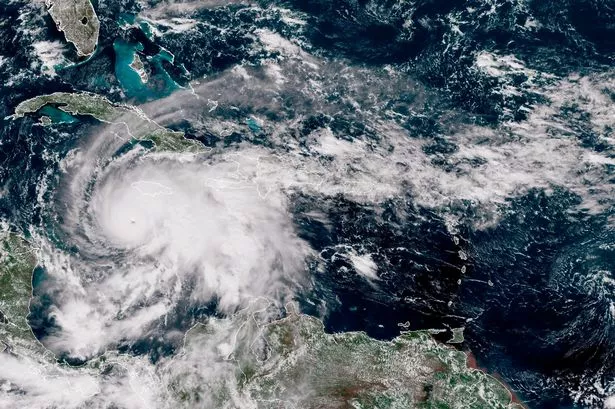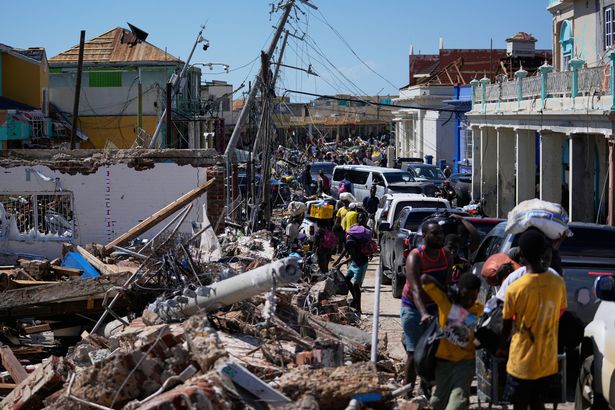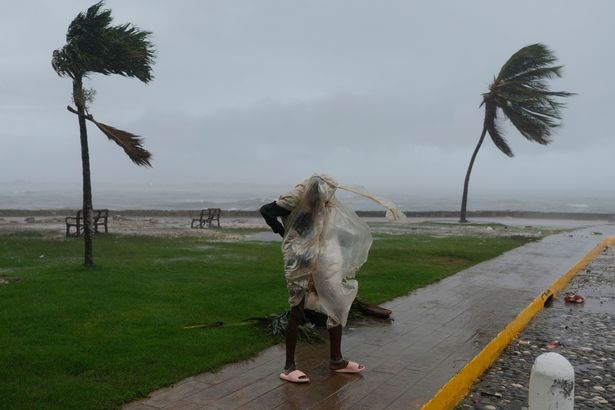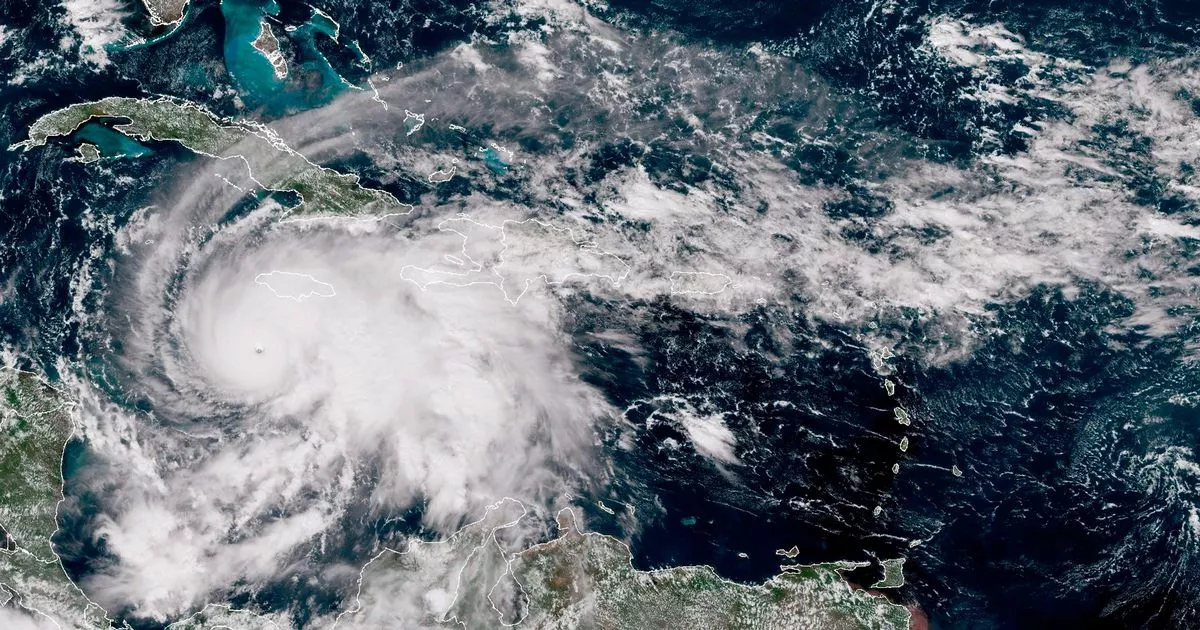The Caribbean is reeling after Hurricane Melissa, and as communities struggle to recover, climate scientists warn that this devastation may be just a glimpse of what the region, and the world, could be about to face. Federica Adriani reports. Hurricane Melissa once again raises the spectre of climate change related extreme weather events.(Image: Getty Images)
Hurricane Melissa once again raises the spectre of climate change related extreme weather events.(Image: Getty Images)
It is still not possible to make a definitive assessment of the destruction wreaked by Hurricane Melissa on the Caribbean Islands. Jamaica suffered the most, exposed to the huge storm’s highest intensity, followed by Cuba, Haiti and the Bahamas.
So far, at least 49 people have lost their lives in Jamaica, and 29 deaths have been confirmed in Haiti, according to Reuters, but the overall death toll is still uncertain.
Hurricane Melissa was listed as a category 5 hurricane when it hit Jamaica, and then was downgraded to category 3 in Cuba, and then reduced to category 1 when it reached the Bahamas. Although the storm is expected to gain more power on its way to Bermuda.
Labelled by the experts as ‘the storm of the century’, the hurricane is the strongest that Jamaica has ever seen and one of the most powerful recorded in the Atlantic Ocean.
Hurricane Melissa once again raises the spectre of climate change related extreme weather events.
“Because of climate change, the sea temperature in the Caribbean has been between 2 and 3 degrees Celsius higher than average, which is why hurricane Melissa was a Category 5.”, Disaster Risk Manager and Disaster Preparedness Specialist Giordano Margaglio told the Manchester Evening News.
“In fact, hurricanes draw energy from warm water temperatures. That means that the warmer the water, the more frequent and powerful hurricanes are going to be. In this instance, it wasn’t just the sea temperature on the surface to be higher, but also the deeper levels below the sea surface.”
“When Melissa happened, Jamaica was still recovering from Hurricane Beryl, which hit the island in 2024,” Margaglio said.
“This is exactly the trend we are seeing at the moment: disasters are becoming so frequent that vulnerable communities don’t even have time to recover from a disaster, and they are pushed deeper into poverty because of a new disaster. And that’s an issue.
“In disaster risk management, we speak a lot about ‘build back better’, which means that we don’t have simply to restore the balance that was there before, but we need to improve it. In this way, communities become more resilient to the next calamity. But the issue is that the hazards are becoming more and more violent, so it’s becoming more difficult for these communities to bounce back.”
 Residents in Black River, Jamaica(Image: AP)
Residents in Black River, Jamaica(Image: AP)
Last year, Margaglio was part of the team of experts who trained Caribbean islands governments to be ready to face natural calamities, hurricanes specifically. For those countries at the forefront of climate change-driven disasters, it’s important to build a network of aid capable of responding promptly when emergencies happen.
“What is positive is that most of these governments are taking proactive actions to prepare better, because they realised they cannot ignore it anymore,” the Preparedness Specialist said.
“They also realised that individual states cannot do that much. We are talking about developing countries, so their capacities are low, and when something like Hurricane Melissa happens, it means that it’s going to take years to recover.
“For this reason, we are setting up aid systems that operate in a regional way, so we are sharing resources and improving capacities to respond. For example, now there are humanitarian aids that they can deploy to the nearest islands that need them the most.
“Obviously, when these disasters happen, we don’t know in advance which island is going to be impacted the most.”, Margaglio explained.
With hurricanes, as with tsunamis, we are talking of ‘transboundary hazards’, because they cross geographical boundaries. Therefore, it becomes crucial to have strategic hubs from where you can deliver aid to the nearest place that needs them the most.
“In this way, even if the single state doesn’t have the resources, together they can respond to the emergency.”, the expert said to the M.E.N.
“The global economic damage from disasters is reaching figures that are in the billions range.
“Every single action we take in preparedness in supporting these communities is going to have an economic benefit for the so-called ‘global north’. Preparedness development work it’s not something that we have to do because we just have to, but because if we don’t do it, everyone is going to pay the consequences.
“And we see that every single dollar that we invest in preparedness is going to save up to 10 to 15 dollars in the recovery from a disaster.”, Margaglio added.
 Residents walk in the aftermath of Hurricane Melissa in El Cobre, Cuba(Image: AP)
Residents walk in the aftermath of Hurricane Melissa in El Cobre, Cuba(Image: AP)
In a post on his official X account, the Prime Minister of Jamaica, Andrew Holness, named the local Office of Disaster Preparedness and Emergency Management as the Jamaican population’s “first point of contact in any disaster situation”.
However, some of the main sponsors of many disaster preparedness programmes are progressively withdrawing funds from the projects.
“A lot of the programmes I work for are financed by the United Nations,”, Margaglio told the M.E.N.
“Like the United Nations Development Programme, which is allocating a lot of funds in disaster preparedness and disaster recovery. Though many funds have been removed and many programmes have been shut down since Donald Trump was elected in the USA.
“A lot of funds for USAID have been cut. That means that they have reduced the staff and, in general, a lot of the programmes across the world have been shut down, simply because the governments are less willing to invest in development programmes.
“At the same time, we all see how critical these resources are for the communities that are at the frontlines of the climate crisis. Once they don’t have these programmes, they are left without any capacities and any resources.”, the specialist said.
The devastation left behind by Hurricane Melissa’s vehemence shows up almost like a warning, less than a fortnight away from the COP 30, the 2025 UN Climate Change Conference scheduled for November 6 and 7 in Belém, Brazil.
“We are not yet sure about how things are going to evolve in a world that is beyond 1.5 degrees Celsius warmer,” Margaglio told the M.E.N.
“It all depends on how much the ‘Global North’ governments are going to commit to pinning down greenhouse gas emissions. Every single portion of a degree matters in shaping what the worlds future is going to look like.”
According to the science magazine Nature, around 143 million people in the Global South are going to be displaced by 2050 because of the adverse events triggered by climate change.
 (Image: Getty Images)
(Image: Getty Images)
While the impact of multiple and increasingly frequent climate disasters on climate migrants’ route patterns is still unknown, many countries seem to have reached their ‘maximum capacity’ when it comes to welcoming migrants.
At the moment, there are already the United Nations High Commissioner for Refugees (UNHCR), in 2024 around 123.2 million people worldwide were displaced because of conflicts, violence and persecutions.
Many studies, including research published by the University of York in 2021, already illustrate how some parts of the planet are going to become uninhabitable by 2100 if immediate actions against climate change are not taken.
In 2020, the Institute for Economics Peace (IEP) estimated that 1.2 billion people might be forced to leave their homes due to natural disasters directly related to climate change.
“The usual migration pattern is from the Global South to the Global North. We already see countries in Europe or even in the US that are struggling with relatively low numbers of migrants. Imagine what is going to happen when we have 1 billion people migrating.”, Margaglio added.
 A man walks in Kingston, Jamaica, as Hurricane Melissa approaches(Image: AP)
A man walks in Kingston, Jamaica, as Hurricane Melissa approaches(Image: AP)
“Considering that many coastal regions might disappear because of sea rises, and that we might have more and more floods and droughts, people will have to migrate from European countries as well.
“For example, Italy, which is the country from which I am from, is going to suffer a lot in the next few years because of climate change. Some agencies have estimated that up to 65% of Italy might be uninhabitable by 2100.
“That’s a longer time frame, but it means that people will have to migrate to the north of Europe. In such a scenario, people would eventually shift closer and closer to the poles.
“Furthermore, the consequences of these waves of migrations are made even more unpredictable by the current political climate.”, the preparedness disaster specialist told the M.E.N.

